Thur, Nov 2 – Manaus
- Manaus is the capital city of the state of Amazonas in the North Region of
Brazil. It is situated near the confluence of the Negro and Solimões (Amazon) rivers.
With a population of more than two million, it is the most populous city of both
the Brazilian state of Amazonas and the Amazon rainforest.
The city was founded in 1693–94 as the Fort of São José do
Rio Negro. It became a town in 1832 with the name of
"Manaus", an altered spelling of the indigenous Manaós people, and
legally transformed into a city in 1848. It is located in the middle of the Amazon rainforest,
and access to the city is primarily by boat or airplane. This isolation helped
preserve both the natural environment as well as the culture of the city. The
culture of Manaus, more than in any other urban area of Brazil, preserves the
habits of Native Brazilian tribes. The city is the main access point for
visiting the fauna and flora of the Brazilian Amazon. Few places in the world
afford such a variety of plants, birds, insects, and fishes.
It was known at the beginning of the century, as "Heart
of the Amazon" and "City of the
Forest”. The city has a free
port and an international airport. Its manufactures include electronics,
chemical products, and soap; there are distilling and ship construction
industries. Manaus also exports Brazil nuts, rubber, jute and rosewood oil. It
has a cathedral, opera house, zoological and botanical gardens, an ecopark and
regional and native peoples museums. It is located on the north bank of the Negro River, 11
miles above the meeting of the rivers where the Negro merges with the Solimões,
to form the Amazon proper. Manaus is 900 miles inland from the Atlantic Ocean. Rubber made it the richest city in South America
during the late 1800s. Many wealthy European families settled in
Manaus and brought their love for European art, architecture and
culture with them.
After a good nights sleep we came down for our continental breakfast. It is so nice to have something besides sweets for a continental breakfast. There was cheese, meat, yogurt, fresh fruit and canned fruit, and fruit we've never experienced before, but no acai berries, and many things we had no idea about. But, the coffee was great. On HAL we had some of the worst coffee we have ever encountered. We wandered if they weren't mixing the brewed coffee with instant so as to make it last longer - it wasn't a problem, we weren't drinking much of it; so this morning it was nice to have some real coffee again.
We checked with the tour desk in the lobby and was told that a city tour, including the opera tour, would be 400 rios; we are being charged 500 through Armstrong. We shouldn't have worried, because he showed up right before 9:00 and introduced us to our tour guide Alfonso, who we had been told would speak English as well as Armstrong did - yeah! Armstrong then tried to talk us in to arranging a pick up to take us to the ship the next morning and then he would pick us back up after we docked and take us to the airport - we passed on this arrangement.
So off we go with Alfonzo and Armstrong. They took us to the park in front of the Opera House and he
walked us around and gave us the history of the area; again, way too much information for this poor overloaded brain. We loved the tiles in the plaza and were told that the light and dark colors represented the meeting of the waters, which we will explain later as we actually saw this phenomenon. We were told that Manaus was
started 348 year ago and there will be a big party in two years when they hit 350 years old. We are having a bit of difficulty this a.m. with the heavy humidity; we are not used it, and it is zapping our energy. We brought plenty of water, so hopefully that will help us out. After touring the plaza and learning of the history we go and explore St. Sebastian church; it is the oldest church in Manaus, it is even older than the Opera House, which is 120 years old, but Armstrong didn't know how old it is. The church is quite cool inside and very lovely. It is quite quaint but at the same time is quite religious without being overly so. It was a lovely church.
Armstrong left us and we are now with Alfonzo who took us into the Amazon Museum. Luckily there were English subtitles on their boards so we could understand what were seeing, and discussed the life of the natives from the past to current. Other than education, these peoples still live a very primitive (according to our standards) life. Their was also a display of current and old dugouts and their nets, both used for fishing. As indicated earlier, Alfonzo doesn't speak good English; and I think he only understands a small amount of what we are asking. It's going to be an interesting tour. Our next stop was to the markets.
Now, if you read the intro to this city you would be painted a picture of a very cosmopolitan city; that is not the case. In all of our travels on this trip, this city boggles the minds. Just like the rest of South
America, there is a mixture of sturdy well built buildings and businesses, with shacks and street businesses. This city is even more so. We are heading over to the local markets which are along the river. Our first market was the fruit market. We have never seen so many bananas in our entire lives. I asked if they grow them there and was told "no, we just like bananas". OK. I asked where they all come from and was told "across the bridge somewhere". Watermelons was the next most plentiful fruit we saw, and then each and every stall had mangoes, papayas, some coconuts, and god only knows what else. It was definitely an experience for the senses. The place was crazy; people are
unloading their trucks of the fruit products while other people are wandering and others are buying massive amounts (maybe for their restaurants?). It was nuts!
The next market was the fish market. Now, we have seen several fish markets along our travels around South America. But this place leaves everything in the dust. These markets are the size of a huge warehouse and every inch of available space is taken up with a stall and they are all selling the same type of fish - I just wish we could have bought some and been able to cook and eat it. This place is amazing. Alfonzo stopped at one stall and while the seller had his back turned he pulled out a Piranha and opened its mouth so we could see the size of the teeth. First of all I was amazed at the size of the fish, I thought they were tiny little fish, not so; and secondly, those teeth were mighty sharp. I attempted to get a picture but it didn't turn out. We were rushed through these markets and did our best to keep up.
Our next Market was in a very nice stucco building, with washrooms and a small restaurant. There were fans blowing and electricity was available. Alfonzo told us this is where everything is cleaner and you pay two times the price as in the previous markets. This place is more like a tourist market with all the crafts and such being sold here. We weren't give any time to shop so we will have to come back.
We were whisked off to the next place, walking rapidly we are brought to the river to see all the fishing boats; further down we see much bigger boats and are told that they are cruise ships or day trip boats for the tourists. At least this is what we think we were told.
We finally got back in the taxi and the air conditioning and were taken to the site of where the city was founded. To develop the site for the offices the current residents had to move. He said that the government would either give you an apartment to live in for life, or they would give you the equivalent of what is today $2,000.00. Well most of the people took the money, but he said that wasn't really smart because the land the apartments were on is still here and you still have a share of it. He then took us over to the Federal building, but today is a holy day, All Souls Day, and all federal buildings are closed. It is getting on to noon and we are to meet Armstrong at the Opera House for our tour. Now, we have heard from anybody and everybody who has been to Manaus to make sure we see this place. We did, it is nice and plush inside, since it was the Rubber Barons who had it built in the heyday of the Rubber Industry; but it just wasn't all that impressive to us. Don't get me wrong, it is quite pretty, and it is the fifth oldest opera house in the word, but we just didn't understand all the hype.
Our next stop is old town, which had some beautiful buildings sitting right next to shacks or buildings crumbling to the ground. He took us to a friends place. This gentleman is an artist, and we were allowed into his garage to see his work.
He had a beautiful lion painted on his garage floor, and as we wandered through he had paintings of animals all over the place - it was great. We thanked him for his time and headed down the street and then down a side street of broken up cement to take a look at the navy base - there were two sentries at the end of the street we walked down, so I guess that is whey we went down the side street to view the complex from a distance.
As we are driving we pass a major military installation and Alfonzo tells that all males have to go through two years of jungle training, and this is where they do it at. We never got this clarified as to whether all males have to do the training, or the military personnel have to do the two years of training. In any event, it was a huge (many blocks long, and who knows how deep the facility goes back). He takes us through the downtown shopping center, and I am seeing all kinds of shops I would like to get out and explore. We did stop at a local pharmacy so Russ could pick some Lipitor; no prescription needed and cheap.
He then attempts to take us to the Aquarium, but it is a holiday and so it is closed. This hit us as odd, as you would think they would be open since everybody is off today; why not go to the museums or aquariums - it would be a great family outing - but that is American thinking, so he took us to the zoo - so we get out an wandered around the zoo - it is a pretty sad zoo and none of the animals are out - they want to be in their cool environments and so would I. We are dying here from the humidity. It's not that hot, just humid and we need some more water - he stops at a water fountain and Russ started to drink and I stopped him. Alfonzo told us it was safe, but I would rather be safe than sorry. We asked him to stop for lunch - he said he would take us to the beach were we could stop at a restaurant - no thanks! We stopped at the local Bob's and got a shake and some bottled water. At the beach we walked around the promenade and were awed by the huge condominiums. He said the condo run more here than they do on the beaches of Rio. Wow.
We are beginning to drag but Alfonzo just keeps on trucking - like that dang rabbit! He drives over the new bridge and stops for us to take pictures. He heads to a certain point on the bridge with Russ, but I head behind where we had parked - he is yelling at me that I need to follow him, and I said I would - after I got the pictures I wanted. It is a cool looking bridge.
We finally have had enough and asked him to drop us off at our hotel. He wants to take us to some other place and we say no, we've had enough. So he drops us off and takes off. Nice, but long day.
We had upstairs and take a nice long refreshing shower and then just kick back and relax. We wander downstairs later for dinner; it was nice, but we are tired. Russ uploaded some of our pictures from the South American cruise; we make sure everything is packed up and ready for tomorrow and hit the bed.

 Manaus, State of Amazonas, Brazil
Manaus, State of Amazonas, Brazil
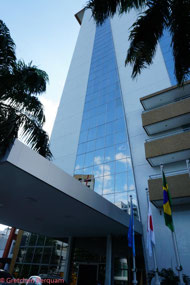
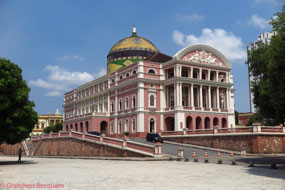
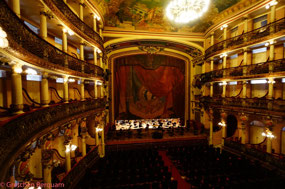
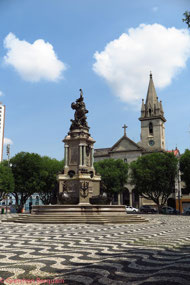
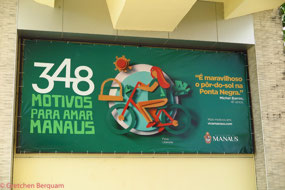
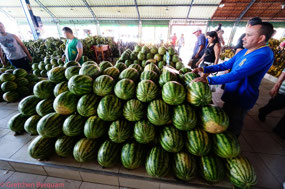
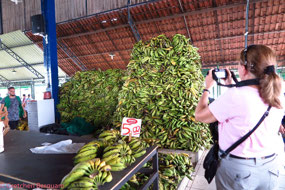
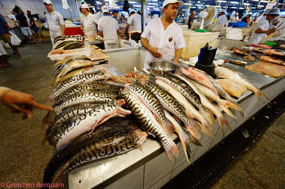
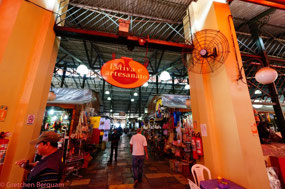
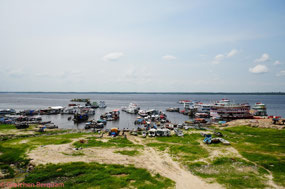
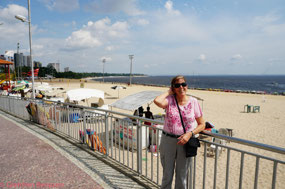
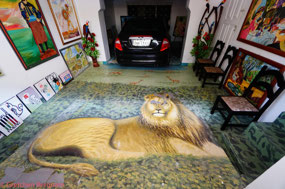
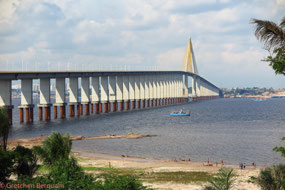











2025-05-22